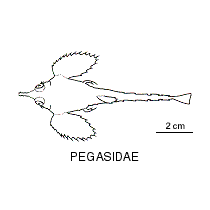- Classification
- ACTINOPTERYGII
- GASTEROSTEIFORMES
- PEGASIDAE
-
Fish Classification
-
Class
ACTINOPTERYGII Ray-finned fishes -
Order
GASTEROSTEIFORMES Sticklebacks -
Family
PEGASIDAE Seamoths
Family PEGASIDAE
Unusual bottom-dwelling fishes with large, horizontal fan-like pectoral fins and small, flattened bodies encased in thick fused bony plates.
Seamoths have pointed heads with the mouth beneath a long flattened bony rostrum. They 'walk' over the seafloor on their finger-like pelvic fins.
More Info
|
Family Taxonomy |
A small family of marine fishes with five species in three genera. Two genera and three species occur in Australian waters. |
|
Family Distribution |
Inhabit tropical and temperate waters of the Indo-Western Central Pacific. Seamoths are bottom-dwelling fishes that live on rocky reefs or muddy, silty, or sandy substrates in bays or estuaries, usually in depths between 1-91 metres, although one species has been recorded at a depth of 152 metres. Juvenile stages are pelagic. |
|
Family Description |
Body small, broad and flattened; encased in bony plates, those of head and trunk fused into two separate hinged, rigid structures, plates on tail hinged and flexible; snout flat and extended, mouth small, positioned on underside, caudal peduncle quadrangular in cross section. Pectoral fins large and wing-like, horizontally oriented; dorsal and anal fins short and opposite, positioned just behind anus; caudal fin fan-like; pelvic fins long, narrow and reduced, immediately in front of anus. and pectoral fins; |
|
Family Size |
Species range in length from 8 to 18 cm. |
|
Family Colour |
Well-camouflaged fishes that readily change colour to match the substrate on which they live. |
|
Family Feeding |
Seamoths are generalised benthic feeders, consuming a variety of small benthic invertebrates including crustaceans and marine worms. Although they do not have tubular snouts like gasterosteiform fishes, Seamoths can form their mouths into a tube-like shape to suck worms and crustaceans from burrows. |
|
Family Reproduction |
Oviparous, sexes separate. Pairs spawn at dusk, rising rapidly off the bottom to release pelagic eggs and sperm into the water column. Eggs are spherical and pelagic, approx 1.0 mm in diameter. Larvae are dorsoventrally compressed and enclosed by dermal sac. The tail is dorsolaterally compressed and encircled by bony rings. The trunk and head are encased by ossified, ridged dermal plates. Body moderately to heavily pigmented. Juveniles are pelagic before settling to the seafloor. |
|
Family Commercial |
Seamoths are taken as bycatch in commercial trawl and seine fisheries. Some species are exploited in the Traditional Chinese Medicine (TCM) industry, and are traded in the aquarium industry. |
|
Family Conservation |
IUCN: All species are listed on the 2010 IUCN Red List of Threatened Species (http://www.iucnredlist.org/). EPBC Act 1999: The family is listed as threatened under the Environment Protection and Biodiversity Conservation Act 1999 (EPBC Act 1999). |
|
Family Remarks |
These unusual little fishes use their pelvic fins to 'walk' or crawl slowly over the bottom, usually swimming only when disturbed. Males and females form close long-term pair bonds. |
|
Family Biology |
Seamoths regularly shed their outer skin layer in a single piece. |
|
Author |
Dianne J. Bray |
References
IUCN 2010. IUCN Red List of Threatened Species. Version 2010.2. http://www.iucnredlist.org/
Kuiter, R.H. 1985. The remarkable sea moths. Scuba Diver 3: 16-18.
Kuiter, R.H. 2009. Seahorses and their relatives. Aquatic Photographics, Seaford, Australia. 333 p.
Leis, J.M. & D.S. Rennis. 1984. The larvae of Indo-Pacific coral reef fishes. N.S.W. Univ. Press, Sydney and Univ. Hawaii Press, Honolulu. 269 p.
Marivic G. Pajaro, M.G., J. J. Meeuwig, B.G. Giles & A. C.J. Vincent. 2004. Biology, fishery and trade of sea moths (Pisces: Pegasidae) in the central Philippines. Oryx 38(4): 432-438.
Pajaro, MG, Meeuwig JJ, Giles BG, Vincent ACJ 2004 Biology, fishery and trade of sea moths (Pisces: Pegasidae) in the central Philippines. Oryx 38(4): 1365-3008. 10.1017/S003060530400081X
Palsson, W.A. & Pietsch, T.W. 1989. Revision of the acanthopterygian fish family Pegasidae (Order Gasterosteiformes). Indo-Pacific Fishes 18: 1-38.
Paxton, J.R. , J.E. Gates, D.J. Bray & D.F. Hoese. 2006. Pegasidae. In Hoese, D.F., D.J. Bray, J.R. Paxton, G.R. Allen, Beesley, P.L. & A. Wells (Eds). Zoological catalogue of Australia. Volume 35 Fishes. ABRS & CSIRO Publishing, Australia. Part 2.
Pietsch, T.W. 1978. Evolutionary relationships of the seamoths (Teleostei : Pegasidae) with a classification of gasterosteiform families. Copeia 1978(3): 517-529, figs. 1-15.
Pietsch, T.W. & Palsson, W.A. 1999. Family Pegasidae (p. 2262). In Carpenter, K.E. & Niem, V.H. (eds) The Living Marine Resources of the Western Central Pacific. FAO Species Identification Guide for Fisheries Purposes. Rome : FAO Vol 4, pp. 2069-2790.
Pogonoski, J.J. Pollard, D.A. & Paxton, J.R. 2002. Conservation Overview and Action Plan for Australian Threatened and Potentially Threatened Marine and Estuarine Fishes. Canberra Environment Australia, 375 p.
Randall, J.E., Allen., G.R. & Steene, R.C. 1997. Fishes of the Great Barrier Reef and Coral Sea. Bathurst, Australia, Crawford House Publishing.
Reader, S.E. & Neira, F.J. 1998. Pegasidae: Seamoths. pp. 117-121. in Neira, F.J., Miskiewicz, A.G. & Trnski, T. Larvae of temperate Australian fishes: laboratory guide for larval fish identification. Nedlands, Western Australia : University of Western Australia press 474 pp.
Reader, S.E., Leis, J.M. & Rennis, D.S. 2000. Pegasidae (Sea Moths). pp. 210-212 in Leis, J.M. & Carson-Ewart, B.M. The larvae of Indo-Pacific coastal fishes. An identification guide to marine fish larvae. Fauna Malesiana Handbooks Leiden : Brill Vol. 2 870 pp.
Smith, M.M. 1986. Pegasidae. p. 443. In M.M. Smith and P.C. Heemstra (eds.) Smiths' sea fishes. MacMillan, South Africa.
Vincent, A.C.J. 1997. Trade in pegasid fishes (sea moths), primarily for traditional Chinese medicine. Oryx 31: 199-208.












































